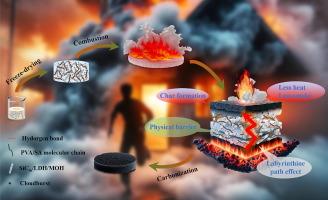具有优异防火性能的超强 SiC/LDHs 生物质气凝胶
IF 13.3
1区 工程技术
Q1 ENGINEERING, CHEMICAL
引用次数: 0
摘要
在宏观生物质气凝胶中组装碳化硅/层状金属氢氧化物(SiCm/LDHs)存在界面相互作用弱等难题,从而降低了其机械性能。我们成功合成了高纵横比的碳化硅/钴铝层状双氢氧化物/氢氧化镁(MOH)三元复合材料,以改善聚乙烯醇(PVA)/海藻酸钠(SA)生物质气凝胶(PS)的阻燃和抑烟性能。SiCm/LDH/MOH(2 wt%)的加入大大增强了 PS 的炭化效果,从而显著抑制了火焰燃烧并减少了烟雾产生。具体而言,与纯 PS 相比,峰值热释放率(pHRR)和总烟雾释放率(TSR)分别降低了 18.4% 和 30.5%。加入 SiCm/LDH/MOH 后,PS 气凝胶的压缩特性明显增强,尤其是 PS-S/L/M-4%,与纯 PS 相比提高了 220.4%。因此,在三元复合材料中形成多个氢键和相互连接的界面结构有利于协同实现优异的机械和阻燃性能。我们的工作为以 SiCm/LDHs 为增强材料的生物质气凝胶的绿色制造提供了更广阔的前景。本文章由计算机程序翻译,如有差异,请以英文原文为准。

Ultrastrong SiC/LDHs biomass aerogel with exceptional fire safety behavior
Assembled Silicon Carbide/Layered Metal Hydroxides (SiCm/LDHs) in macroscopic biomass aerogels have challenges such as weak interfacial interactions, which degrade the mechanical properties. We successfully synthesized silicon carbide/cobalt-aluminum layered double hydroxide/magnesium hydroxide (MOH) ternary composites with high aspect ratios to improve the flame retardant and smoke suppression properties of polyvinyl alcohol (PVA)/sodium alginate (SA) biomass aerogel (PS). The inclusion of SiCm/LDH/MOH (2 wt%) greatly intensified the charring effect of PS, leading to a notable suppression of flame combustion and a reduction in smoke production. Specifically, the peak heat release rate (pHRR) and total smoke release (TSR) were decreased by 18.4% and 30.5%, respectively, in comparison to pure PS. The compressive characteristics of PS aerogels were notably enhanced through the incorporation of SiCm/LDH/MOH, particularly PS-S/L/M−4%, which exhibited a 220.4% increase compared to pure PS. The favorable formation of multiple hydrogen bonds and interconnected interfacial structures in ternary composites thus synergistically contributes to the achievement of superior mechanical and flame retardant properties. Our work offers a brighter future for the green manufacturing of biomass aerogels reinforced with SiCm/LDHs.
求助全文
通过发布文献求助,成功后即可免费获取论文全文。
去求助
来源期刊

Chemical Engineering Journal
工程技术-工程:化工
CiteScore
21.70
自引率
9.30%
发文量
6781
审稿时长
2.4 months
期刊介绍:
The Chemical Engineering Journal is an international research journal that invites contributions of original and novel fundamental research. It aims to provide an international platform for presenting original fundamental research, interpretative reviews, and discussions on new developments in chemical engineering. The journal welcomes papers that describe novel theory and its practical application, as well as those that demonstrate the transfer of techniques from other disciplines. It also welcomes reports on carefully conducted experimental work that is soundly interpreted. The main focus of the journal is on original and rigorous research results that have broad significance. The Catalysis section within the Chemical Engineering Journal focuses specifically on Experimental and Theoretical studies in the fields of heterogeneous catalysis, molecular catalysis, and biocatalysis. These studies have industrial impact on various sectors such as chemicals, energy, materials, foods, healthcare, and environmental protection.
 求助内容:
求助内容: 应助结果提醒方式:
应助结果提醒方式:


